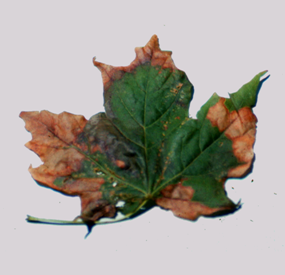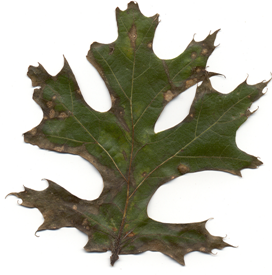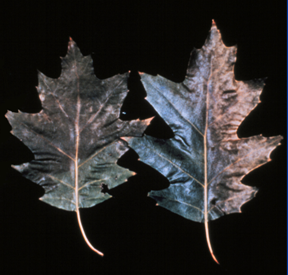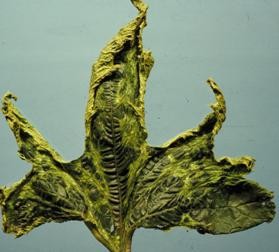
What is tatters?
Tatters is a leaf disorder affecting primarily members of the white oak group of oaks (i.e., oaks with leaves with rounded lobes) including bur, white and swamp white oaks. Members of the red oak group of oaks (i.e., oaks with leaves with pointed lobes), including red, black, pin and shingle oaks, as well as other types of trees, rarely display the disorder. Tatters was first documented in Iowa, Indiana and Ohio in the 1980’s, and since then has been documented throughout much of the Midwest.
What does tatters look like?
Trees with tatters have leaves that are lacy and shredded. Some leaves may appear as though the tissue between veins has been neatly ripped out, while other leaves have an irregular pattern of damage. The amount of damage may vary from leaf to leaf and branch to branch. Adjacent oak trees may show different amounts of damage due to genetic variability, variation in environmental conditions, or other external factors. Tatters is commonly confused with herbicide damage (see UW Plant Disease Facts D0060, Herbicide Damage), or damage by leaf-feeding insects.
Where does tatters come from?
The cause of tatters has not been precisely determined. Tatters is thought to be a physiological disorder caused by damage to leaf tissue (e.g., cold injury) in the bud-stage or during the opening of buds in the spring.
How do I save a tree with tatters?
Do not panic! Trees affected with tatters often produce replacement leaves within two to three weeks after tattered leaves appear. However, producing new leaves weakens trees and may make them more susceptible to other diseases and drought stress. If your trees suffer from tatters, make sure they receive sufficient water (approximately one inch per week for established trees). If rainfall is insufficient, use a drip hose or soaker hose to apply supplemental water around the drip line of the tree (i.e., the edge of where the branches extend). To prevent competition for water and nutrients, remove grass within the drip line of your trees and replace it with shredded hardwood, pine or cedar mulch. On heavy, clay soils, use one to two inches of mulch. On lighter, sandy soils, use three to four inches of mulch. Be sure to keep mulch four inches from the tree trunks. Fertilize trees only based on a soil nutrient test.
How do I avoid problems with tatters in the future?
There is no known method for preventing tatters. However, the occurrence of tatters one year does not guarantee that the same trees will suffer from tatters in subsequent years.
For more information on tatters:
Contact the University of Wisconsin Plant Disease Diagnostics Clinic (PDDC) at (608) 262-2863 or pddc@wisc.edu.
Authors: Rachel Leisso* and Brian Hudelson, UW-Madison Plant Pathology
Last Revised: 03/02/2024
D-number: D0111
* Completed as partial fulfillment of the requirements for Plant Pathology 699 – Plant Pathology Special Topics at the University of Wisconsin-Madison.
References to pesticide products in this publication are for your convenience and are not an endorsement or criticism of one product over similar products. You are responsible for using pesticides according to the manufacturer’s current label directions. Follow directions exactly to protect the environment and people from pesticide exposure. Failure to do so violates the law.
Thanks to Diana Alfuth, Phil Pellitteri and Ann Wied for reviewing this document.
A complete inventory of UW Plant Disease Facts is available at the University of Wisconsin-Madison Plant Disease Diagnostics Clinic website: https://pddc.wisc.edu.
Send a Plant Sample for Analysis
Be cautious when self-diagnosing plant health issues. Very few diseases can accurately be diagnosed by eye.
Contact the UW Plant Disease Diagnostics Clinic (PDDC), and for a small fee, clinic staff can examine a plant, determine the cause of the disease/disorder, and provide advice on how to control or prevent the issue.
Download Article





 Anthracnose
Anthracnose Tubakia (Actinopelte) Leaf Spot
Tubakia (Actinopelte) Leaf Spot Oak Wilt
Oak Wilt Herbicide Damage
Herbicide Damage


